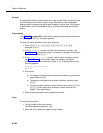
Hunt Group Extensions (#505)
5-161
Hunt Group Extensions (#505)
Description
This System Programming procedure lets you assign any number of extensions to
a Hunt Group. The system supports up to eight Hunt Groups; however, Hunt
Group 7 is used exclusively for the voice messaging system and Hunt Group 8 is
used exclusively for transferring and detecting fax calls.
Related Features for Hunt Groups 1–6
■ For instructions on ringing or paging extensions in a Hunt Group or
transferring calls to a Hunt Group, see Group Hunting.
■ If a ringing call to the Hunt Group is not answered within three rings, the
call moves to the next available extension in the Hunt Group. If users in the
Hunt Group leave their desks, they should turn on Do Not Disturb at their
extensions so calls hunt immediately to the next available extension.
■ For instructions on making outside calls ring directly in a Hunt Group, see
Group Call Distribution (#206).
■ Hunt Group calls are not eligible for Call Coverage or VMS Cover.
■ When using PARTNER MAIL Release 3 or later, a call to a busy Hunt
Group can be sent to a Hunt Group mailbox.
Related Features for Hunt Group 7
■ This Hunt Group applies only to the voice messaging system. For more
information, see VMS Cover Rings (#117) or (#321), Group Call
Distribution (#206), Line Coverage Extension (#208), Automatic VMS
Cover (#310), VMS Hunt Delay (#506), VMS Hunt Schedule (#507),
Voice Mailbox Transfer, and VMS Cover.
■ After you assign the extensions associated with the voice messaging
system hardware to Hunt Group 7, you should set the Transfer Return
Extension (#306) for those extensions to extension 10 (or another
extension with a person who can assist the caller).
Related Features for Hunt Group 8
■ This Hunt Group applies only to transferring and detecting fax calls. For
more information, see Fax CNG Detection (#505, Group 8).
■ Hunt Group 8 should not be used as a standard hunt group, since calls are
automatically transferred to this hunt group.


















